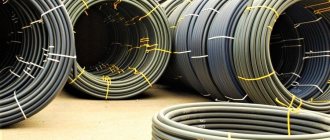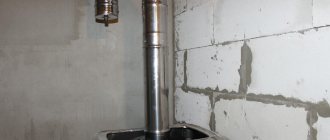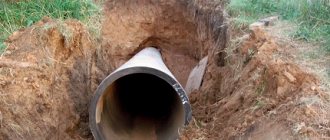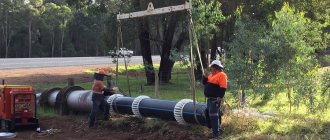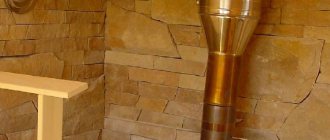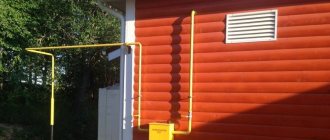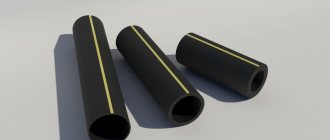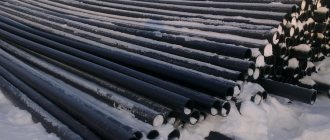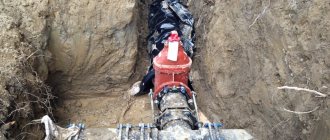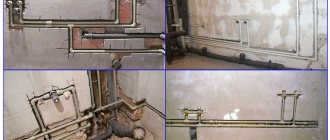If you have a private house or cottage, then this issue will become one of the decisive ones, because any building needs a water supply system, a gas pipeline and a sewerage system. In the twenty-first century, there are a huge number of opportunities to protect housing from environmental and atmospheric influences. The safest and lowest-cost method is to install sleeves.
In most cases, pipeline sleeves must be used
Several theses follow from this.
- Do I need to use sleeves or other materials to pass pipes through walls?
- Which cases are better?
- Which material is the most resistant?
- What is the internal volume of penetration in the floors?
- How to seal?
- At what distance from the partitions should it be located?
- What installation difficulties can you encounter?
- Is it possible to lay heating through walls using a sleeve?
Read the article and you will find the answers you are interested in.
Installing sleeves is the most cost-effective and safest way
Purpose of the protective case
The use of the case is due not only to the protection of the gas pipeline itself from the effects of an aggressive environment and various damages, but also to ensure safety for others.
Everyone knows that a gas leak is a very dangerous phenomenon, so additional protection, in this case, is not a luxury, but a necessary condition. The laying of pipes using a protective casing is strictly regulated in accordance with regulatory documents - SNiP 42-01 and SNiP 32-01. According to the requirements specified in the latest document, not only the pipe laying process itself is regulated, but also the distance at which the ends of the protective casing should be located.
In particular, if we are talking about railway tracks, then the protective case must pass through them and have a length of at least 50 meters from the exit. This great importance is justified by the fact that natural gas is very explosive, and trains have a very high mass. As for highways, the cases must protrude 3.5 meters from the exit. In addition, there are precise instructions on the depth of laying the pipeline, which is about one and a half meters.
Making a case
In accordance with the same regulations, cases must be made of steel pipes. The diameter may be different, because it all depends on the parameters of the diameter of the gas pipeline pipe, but, in general, the diameter will not vary much, the spread will be within 10 cm.
Base
Sewer liners are installed in accordance with the requirements of SNiP. There are several reasons for this:
- Under the influence of temperature, pipelines expand or move. To prevent deformation and damage to pipe sections, holes are made. They install products that can maintain the integrity of the system during installation or temperature changes.
- If it is necessary to dismantle the pipeline, the sleeve allows the work to be carried out without destroying the load-bearing structural elements.
- A properly equipped sewer passage through the ceiling serves as an obstacle to unpleasant odors and insects from other rooms.
Also read: Flushing sewer networks - methods
How can highways be laid?
The gas pipeline can be laid underground or above ground. The latest technology is the most economical. The method of laying underground is considered safer. This is how gas pipelines are usually pulled through populated areas. However, the implementation of such a technique is more expensive. Such a highway is also more expensive to maintain.
Some sections of the network in large populated areas can also be laid above ground. But they are almost never too long. Aboveground gas pipeline installation is also provided on the territory of industrial enterprises.
Before starting the installation of the network, it is mandatory to draw up its diagram. The highway project, according to the regulations, must be carried out in topographical terms.
Passage of a flue through the wall of a building
The most successful way to exit the gas duct in the partition is from the pediment side. But if this cannot be done and the chimney comes out from the side of the slope, then we weld the stand and attach the structure to it with sliding fasteners. The result is an intelligent and long-lived system.
Diagram of the chimney exit through the wall and one of the implementation options
Ventilation and safety
When installing a geyser, an exhaust pipe must be used (read: “The nuances of installing exhaust pipes for a geyser - expert advice”). It is prohibited to use flexible corrugated aluminum pipe for these purposes. Exhaust pipes for the column can only be steel or galvanized. It is recommended to equip a geyser, like any other heating device, with fuses: they will shut off the gas supply if the flame goes out.
Features of arranging a gas pipeline in the kitchen from thin-walled metal pipes:
- The work begins by turning off the gas supply valve.
- If the gas pipe in the kitchen needs to be moved, the gas pipe should first be purged to remove any remaining gas from the system.
- The gas pipe on the wall must be very well secured. For this purpose, the product package includes clamps and brackets: they are used taking into account the diameter and length of the pipeline.
- When passing an electric cable near a gas pipeline, a distance of 25 cm should be maintained between them. The gas system and the electrical distribution panel should be 50 cm apart from each other.
- The gas-piped kitchen system should not be adjacent to cooling appliances such as a refrigerator or freezer. If you cover the gas pipes with a refrigerator, its radiator will most likely overheat.
- When installing thin-walled gas pipes, heaters and gas stoves should be removed.
- It is prohibited to lay gas pipes in the kitchen along the floor surface, under the sink, or near the dishwasher.
- When carrying out repair work, it is advisable not to use artificial light sources. The room must be constantly ventilated.
These standards can be used as a guide when operating both ready-made gas systems and when installing or moving gas pipelines.
Types of pipelines
The order in which networks pass through walls or ceilings largely depends on what kind of communications are being laid. Let's figure it out.
Water pipes
If this network is installed using steel products, the general recommendations outlined above should be used. In this case, the surface of the pipe in the area where the wall or ceiling intersects must be protected with a moisture-resistant coating. For cold water supply, it is also necessary to provide a thermal cover, which will prevent the formation of condensation on the surface of the line and will extend the service life. When using a polymer or combined pipe, you must follow the manufacturer's recommendations set out in the product annotations.
If there is groundwater pressure at the entry point of the pipeline into the house, then special waterproofing sleeves can be used to prevent water masses from entering the internal (basement) rooms.
Sewerage
Cast iron products do not require sound insulation and reinforcement, and also do not require the mandatory arrangement of sleeves, which, however, can complicate the process of repair work. Plastic requires a steel pipe sleeve; for example, a larger cross-section product made from roofing steel can be used. The diameter of the part should be 15-20 mm greater than that of the pipe, and the length should be 20-30 mm greater than the width of the wall. The structure at the point of passage through the ceiling is wrapped with waterproofing material, and the passage section itself is sealed with cement mortar.
Worth paying attention! Do not use roofing felt or other organic materials that have an adverse effect on the plastic as wrapping material.
Heat pipe for steam heating
The mandatory use of sleeves for steam heating networks is due to thermal deformations of the metal and stress on straight sections of pipes during sudden temperature changes, which can cause the formation of cracks in building structures and failure of the heating system. In fact, the design and position of the sleeve for passing through ceilings is identical to that for hot water supply systems. When passing through interior walls, not steel, but combined or plastic pipelines from various manufacturers can be used. Their specifications provide for individual fastening and connecting elements, including a sleeve for passing pipes through the wall. Often these parts are high-tech and provide the required level of pipe sliding, which is due to different parameters of expansion and deformation of plastic from different manufacturers.
Chimney
If the chimney is made of steel elements, then when passing through the ceilings it is necessary to use a hollow galvanized iron sleeve, while the upper and lower surfaces are additionally insulated with a fireproof plate. If building structures are made of flammable materials (for example, wood), then the outside of the hollow sleeve is additionally insulated with non-flammable insulation, for example, basalt fiber or asbestos. From a fire safety point of view, the arrangement of the chimney passage in the roof requires special attention.
Do not forget to follow building codes and regulations, and you are already familiar with the main subtleties and nuances of installing liners.
How to install gas pipes inside the house
In the design documentation, the gas pipeline route along the site must be laid in such a way that the pipe enters the wall of a non-residential premises. A boiler room is optimally suited for this purpose. It is the most convenient way to carry out internal gas distribution.
In existing buildings, the rules allow pipes to be laid through living spaces. This applies to situations where the layout of the building does not allow choosing a different option. The gas pipeline, called transit in this case, should not have shut-off valves or threaded connections. This requirement is quite logical. This is explained by the need to prevent gas leakage into living rooms.
To enter a gas pipeline into a house, a hole is drilled in the main wall and a steel sleeve (case) is placed in it. The gaps formed between the sleeve and the wall are sealed with elastic material (rubber sleeve or silicone). The ends of the sleeve must protrude from the wall at a distance of at least 3 cm. Let us immediately note that inserting the pipe through the foundation, as well as laying it under it, is prohibited.
The main method of internal wiring is open. Of course, the appearance of the gas main does not decorate the premises. However, we have to come to terms with this, since this requirement is dictated by security considerations.
The good news for owners who pay great attention to interior aesthetics is that the rules allow hidden installation. It is performed in grooves (furrows) cut into the surface of the walls
They are covered with easily dismantled screens equipped with ventilation holes. Docking of pipework (threaded and welded) laid inside the groove is not permitted. All internal gas pipes, including those laid in a hidden way, must be painted with waterproof paints. At the points where the pipe connects to gas equipment, the rules require the installation of shut-off valves.
What not to do when installing gas pipes internally
The prohibitions regulating installation operations look like this.
- Installation of gas distribution in ventilation shafts is not allowed.
- Thin-walled gas pipes should not cross door and window openings.
- The gas pipeline must be separated from the floor surface by at least 2 meters.
- The length of flexible sections of the highway cannot be more than 3 meters, while ensuring maximum density of joints is mandatory.
- Pipes are allowed to be laid in well-ventilated areas with a height of at least 2.2 meters.
- Wiring is prohibited in places that are difficult to access for inspection and repair. The exception is easily dismantled wall cladding structures.
- The ventilation of the kitchen, where gas pipes will be installed, cannot be combined with other living spaces.
- The finishing of the ceiling and walls located near the gas pipe must be made of non-combustible materials.
- The fastening of the internal gas pipeline must be reliable. For this purpose, steel staples and clamps equipped with a rubber gasket should be used.
There are a number of requirements regarding the relative position of gas distribution and other utilities, household appliances and equipment. Let's list them:
- When laying parallel, the distance between the gas pipe and the electrical cable must be at least 25 cm. If they intersect, the gap must be at least 10 cm.
- The electrical distribution panel must be at least 50 cm away from the gas pipeline.
- There must be a gap of at least 1 meter from the open electrical wiring bus to the gas pipe.
- It is not recommended to place freezers and refrigerators in close proximity to gas distribution. The pipe running behind the refrigerator impairs the ventilation of its radiator grille. As a result, overheating and breakdown of the household appliance may occur.
- Do not install gas pipes behind a gas water heater, or place them close to heating appliances and a gas stove.
- In the kitchen, it is prohibited to lay pipe lines on the floor, under sinks and near dishwashers.
Differences in introducing bottled gas
Gas cylinders are placed in a metal box outside the house, and the connection to the stove is made through a flexible rather than metal hose.
Installation diagram of gas equipment in a system with cylinders. The rubber hose is protected by a reliable metal sleeve installed in the wall of the house.
The house is made of timber, and the gas supply hose is of small diameter, so making a hole and installing the case is not difficult.
Image gallery
Photo from
Hole in the wall of a wooden house
Gas hose entry from the inside
Adapter from rubber to bellows hose
Metal sleeve on the outside of the house
You cannot install the sleeve between beams or logs; it is recommended to drill a hole in the middle.
Pipe transfer
The decision whether it is possible to cut or move the gas pipe in the kitchen will be up to the relevant services. You are only free to propose network redevelopment and voice your option. And professionals will tell you whether such changes are real, whether they will pose a threat to people’s lives, and will also tell you how much such an “upgrade” will cost you. Where to begin? Where should I knock?
Any pipe transfers must be coordinated with the relevant services
Registration of permission
Remember the step-by-step instructions for preparatory actions and coordination of plans for moving gas pipes:
- Contact the gas service according to the place of registration. It happens that you need to “knock” on some subsidiary structure of this organization: they will explain everything to you on the spot.
- Filling out an application. You will be provided with a sample application, on the basis of which you must write statements on your behalf on what changes you want to make (the application serves as the basis for a specialist to visit you).
- Inspection of the home by a gas service representative. The master will listen to you, examine everything, check it, make the correct calculations (taking into account compliance with all standards). It is not a fact that the expert will reject your plan; it happens, especially with a diligent approach and the homeowner studying the rules, that the master does not have to edit anything.
- Drawing up an estimate. This is, in fact, what the office you contacted does.
- Coordination of the estimate. When the plan is ready, it will be given to you so that you can read the documents and give your consent to carry out this type of work.
- Payment. If you are satisfied with the estimate, you should pay for this service. If not, then don’t be upset, it can be improved, you just tell the master what you don’t agree with, and he will find a compromise offer.
Don't forget to install taps to shut off the gas if you want to change the stove
Preparation for the process
If you agree on the estimate, then within 5 days (usually) a team will knock on your house, ready to move the pipes according to your wishes. Do you need to prepare for the arrival of the masters? If you want the work to be carried out quickly, efficiently, and your home not to be damaged by the workers’ visit, you should do the following:
- contact the craftsmen and find out if you need to provide any consumables (so as not to run after them while the team is working, frantically looking for someone of your own who will look after the apartment, after all, strangers are working);
- free up the space where it is planned to dismantle and install new pipes - workers must have unhindered access to the network;
- cover all kitchen surfaces, appliances and other valuable items, because the craftsmen will be cutting, cooking, dusting and littering (it is better to use coatings that are not prone to burning as a material, for example, tarpaulin, burlap);
- close the valve to stop the flow of blue fuel to the pipes.
Siphon connection simplifies the process of connecting elements
Work order
Of course, you will be interested in learning how to cut a gas pipe in the kitchen and carry out installation, because you will probably want to control the process, or even risk doing the entire block of work yourself (it’s up to you to decide).
So, get acquainted with the process step by step:
- After shutting off the gas, blow out the pipes to remove any debris.
- Cut off the excess part of the system.
- Plug the hole that appears.
- Make a hole in a different place - where you plan to connect a new network segment (using a drill is acceptable).
- Weld the new structure to the gap.
- Weld other parts if required by the design.
- Install the faucet.
- Seal the joints with tow.
- Connect the device (stove, column).
- Check the quality of the work (if the transfer will be carried out by a gas service, ask the master for a certificate of completion of the work).
One last thing: if moving the pipes is not possible, come up with a design to hide them. Now there is a lot of material on this topic, so luck will certainly smile on you
And lastly: gas pipes in the kitchen are not a toy; treat all work related to blue fuel with seriousness and responsibility.
Cost in the estimate for sleeves when installing the roof
The next type of work that may require inclusion in the estimate of the cost of installing liners is the installation of roofs and roofing coverings. The collection that brings together standards for roofing, as part of the current cost estimate and normative bases, is FERr58.
However, it should be noted that this collection is located in the repair and construction part of the FER database, therefore, obviously, it can be used primarily to determine the cost of repair work on the roof. However, in the composition of FERr58 it is possible to find a price for a sleeve for an estimate.
In the FERr58 collection there is a standard FERr58-23-1, which is most often used as a price in the estimate for the installation of sleeves. The specified norm is shown in Figure 2 for demonstration purposes.
Figure 2. Norm FEr58-23-1
The scope of work, the prices for installation of the liner in the estimate for the roof under the code FERr58-23-1 takes into account a fairly wide range of manipulations. First of all, this standard provides for cleaning the roof surface. Next, you need to install a concrete pad.
After this, the price in the estimate for the sleeve under the code FERr58-23-1 takes into account the covering of the entire prepared roof surface with red lead-impregnated burlap. Upon completion of all the above processes, the sleeve is laid. It should be noted that the FERr58-23-1 standard also takes into account the caulking of gaps with resin tow.
However, the scope of work of the FERr58-23-1 standard does not end with the installation of liners. In addition to the operations listed above, this price in the estimate for the installation of liners also includes work on installing a roofing material covering on the roof. In this case, this type of coating is made using mastic in 3 layers.
The final stage in the specified price in the estimate for sleeves is the installation of aprons, which are secured with clamps. The scope of work is normally measured in pieces of installed structures.
It should also be noted that the price in the estimate for the installation of sleeves under the code FERr58-23-1 takes into account most of the necessary resources that are used in the production of work of this type. However, the brand and cost of materials such as concrete mix and sheet steel must be taken into account as part of the estimate form based on the design documentation for the facility.
Control tube
The control tubes are lowered with their free end into the tank to different depths and end at levels corresponding to the controlled volumes. Shut-off needle valves are screwed onto the outer ends of the tubes, the opening of which determines from the exiting gas stream whether it is gas or liquid. To reduce the risk of being struck by a gas stream, a throttle with a diameter of 3 mm is installed in front of the valve. When opening valves to check the level of liquefied gas, operating personnel must always wear gloves on their hands and stand to the side of the valve outlet fitting to prevent the escaping gas stream from hitting the operator, especially exposed, unprotected parts of his body. In cases where the evaporation capacity of the tanks is insufficient to supply gas to consumers, piping the tanks with evaporation units is used.
| Relief safety valve. |
The control tubes are lowered with their free end into the tank to various depths to the levels of the controlled media.
Control tubes are more effective on a gas pipeline that is located above the groundwater level. In some cases, devices are installed that block the gas from leaking into the danger zone and make it easier to detect. A loosened strip of earth allows gas to escape as it spreads from the leak point towards basements and buildings. To control leaks and remove gas in the desired direction, in some cases permanently open drains, similar to control tubes, are installed.
The control tube is a U-shaped tube filled with soda lime and calcium chloride in approximately equal quantities. The layers of calcium chloride and soda lime should be separated at the bottom with a small piece of cotton wool (Fig. 45), and at the top they should not reach 6 mm to the side outlet tubes; they are covered with pieces of cotton wool on top; The tube is closed with stoppers and filled with Mendeleev's putty. Rubber tubes covered with scraps of glass rods are also placed on the side tubes.
| Main characteristics of safety relief valves. |
The control tube (Fig. VI-33) is made of a steel pipe with a diameter of 2, the lower end of which is welded to a casing made of sheet steel 2 - 3 mm thick and 350 mm wide, bent in the form of a semicircle and usually placed above the joint of the gas pipeline. The space between the casing and the gas pipeline is filled with a layer of crushed stone or gravel. The upper end of the control tube is equipped with a stopper, brought to the surface of the earth and protected by KB-ver.
| Control tube device. |
Inspection tubes are of great importance for correct operational supervision; They are the main device that makes it possible to check the density of a gas pipeline from the surface of the earth.
Control tubes can only conditionally be classified as devices that protect underground gas networks from damage. Their main task is not to protect, but to create conditions that allow timely detection of a gas leak from a pipe, take urgent measures to protect the gas pipeline from further damage, as well as eliminate possible consequences of the leak.
Control tubes are installed along the gas pipeline route at certain distances, as well as above points in the gas pipeline for which it is desirable to carry out systematic operational supervision.
| Control device Installation for suction and tubing of gas from the ground. |
Inspection tubes are of great importance for correct operational supervision; They are the main device that makes it possible to check the density of a gas pipeline from the surface of the earth.
Control tubes are brought to the surface of the earth under the carpet in accordance with the requirements of 2 - 1 - 5 of these Rules.
| Reservoir head. |
Traditional solutions
Typically, to seal the gap of the 1st passage of pipes, the following is used: - a heel (woven rope, rope, made of organic or synthetic material, impregnated with an oil-containing solution to improve the sealing properties of the fiber); — sealants; — construction foam; — cement mixtures; - combinations of materials (cabinet and cement mixture);
General disadvantages of using traditional materials for compaction and sealing (cabbage, foams and sealants, cement mixture): - fragility, over time they cake, lose their original volume and elasticity, every spring-autumn period, as a rule, there is a need for work to prevent leaks;
- cannot withstand pressure of more than 2 bar, are squeezed out of the hole, leak; - absorb moisture; - poorly compensate for vibration (water hammer) and other operational loads (temperature changes) on working pipes, which is why gaps and cracks appear in the seal through which moisture seeps in; - if leaks occur, they are beyond repair; cleaning of the interpipe space and their complete replacement are required.
The usual consequences for basements are leaks, containers placed under the ends of the sleeves to collect leaking water, rusty streaks on the walls, standing groundwater, high humidity, corrosion of pipes and metal structures, and in the worst cases, the appearance of fungus and mold. In a humid and warm room, conditions are created for the reproduction of insects, which, through the ventilation system and open doors, enter higher-lying apartments and offices. Thermal chambers are often filled to the groundwater level, even in modern residential complexes.
We suggest you familiarize yourself with How to attach lining to a wall or ceiling
Prolonged penetration of moisture into premises creates conditions for the formation of mold and mildew, which negatively affect health, as well as the structural elements and decoration of buildings, houses, and their internal contents (equipment, furniture, textiles, etc.). Fighting mold is quite expensive, not environmentally friendly, and often impossible.
Advantages of gas communications made of polyethylene
Polymer pipes have an undeniable advantage over similar steel products because:
- They are absolutely not susceptible to corrosion under the influence of an aggressive environment. This provides a lower estimate of the costs required for the construction, maintenance and repair of the gas pipeline.
- The polymer is very easy to process (cut and weld) if it is necessary to adjust the pipe.
- The manufacturing technology of polyethylene pipes makes it possible to make their inner walls absolutely smooth, which significantly increases the throughput of the gas pipeline.
- During operation of such pipes, there is no reduction in their throughput due to clogging of the walls with various substances, since they are very smooth and elastic.
- The polymer from which the pipes are made is not capable of entering into a chemical reaction with any other chemicals. Therefore, the gas pipeline does not require additional protection.
- Polyethylene is not a conductor of electric current. That is why pipes made from it are not afraid of the occurrence of stray currents in them, which could lead to an accident as a result of a gas explosion. That is, when using polyethylene pipes for laying underground gas communications, there is no need to place them in an expensive steel case, which would require an increase in construction costs.
- Polyethylene pipes have excellent flexibility, which is very good when laying gas pipelines using horizontal directional drilling, when the well has sharp enough turns to avoid various obstacles. For example, the maximum bending radius of such a pipe can reach a value equal to 10 times its outer diameter. This allows you to significantly reduce the cost of purchasing connecting elements.
- The polymer has a weight that is significantly lower (7 times!) than the weight of a similar pipe made of steel. This property greatly facilitates the laying of the gas pipeline, which significantly reduces the cost of its construction.
- Polyethylene pipes have excellent resistance to temperature changes, which increases the reliability of gas communications. Manufacturers guarantee that a gas pipeline made of polyethylene pipes will last 50 years or more without reducing its original performance characteristics (this is almost three times longer than the warranty period of steel gas pipes).
However, despite all the advantages of polymer pipes, there are a number of restrictions that do not allow the construction of gas pipelines using them.
In what cases is the use of polyethylene pipes not allowed?
There are a number of conditions that limit the use of polymer pipes in the construction of underground gas pipelines. The use of polyethylene pipes is prohibited:
- If, in the conditions of a given area, freezing of the soil is possible, as a result of which the temperature of the pipe wall can drop below -15°C (this is possible at an ambient temperature below -45°C).
- If liquefied hydrocarbon gas flows through them.
- In areas where earthquakes with a magnitude exceeding 7 are observed, if it is impossible to provide ultrasonic monitoring of the integrity of welds.
- When constructing gas pipelines of ground (above-ground), external and internal types, as well as when laying pipes inside tunnels, channels and collectors.
- When a gas pipeline passes over various obstacles, both natural and artificial (for example, over roads or railways).
Now, having some knowledge on choosing the type of gas pipeline and the rules for its installation, you can begin going through all the stages of constructing gas communications on your site.
Features of use
For sleeves, sections of pipe products are used. Experts call steel or polymer the best option for this. The choice of material is influenced by the design of the building. So, for example, for reinforced concrete buildings it makes sense to install elements made of steel, which are not difficult to concrete both in the factory during the production of wall panels, and at construction sites when installing heating lines.
Installation of a steel sleeve into a hole without machining the end parts is not allowed. Thus, during installation it is possible to harm the polymer pipe product. If the cartridge is installed in a wall made of other materials, then their low adhesion to cement mortar should be taken into account.
It is not recommended to use construction roofing felt for the cartridge. In this case, a poor reaction of the polymer to oil-containing materials is noted.
How to choose the type of gas pipeline
There are two types of individual gas pipelines: above-ground and underground routes. In each option, the gas pipeline is connected in its own way, the distribution of gas throughout the house, rooms and floors is carried out in the same way: you only need to comply with the requirements and standards of the Construction Code. The cost of the work depends on the chosen gas connection: underground gas pipes in a private house, the installation standards of which are described in the above-mentioned construction specifications, are much more expensive to install due to the large volumes of excavation work - approximately 50-60%. However, this solution is considered more reliable due to the following points:
- The underground gas route is more protected from the environment - temperature changes, moisture and wind, and it is almost impossible to mechanically damage such a pipeline, which, due to the combination of conditions, makes the service life of gas pipes much longer than when laid above ground.
Laying an underground gas pipeline
- The advantage of an onshore gas pipeline is its low cost. In addition, the composition of the soil in the gas pipeline section may be such that the metal in the ground begins to quickly rust and deteriorate, which will not happen when laying pipes on the surface. And the last advantage: if gas pipes are long, it is cheaper to stretch them by air, rather than dig trenches for them, insulate them and protect them from aggressive influences.
Overground gas transportation through pipes
Structure of sleeves in walls and ceilings
The first requirement when integrating pipelines, gas pipelines and sewerage into building structures is the continuity of the insulating layer. This requirement is due to the fact that in the presence of cracks, holes and other defects, air and dust begin to enter the pipes, as a result of which they are deformed and destroyed. Naturally, after building a residential building, you do not want to encounter a similar problem, the solution of which will not only take a huge amount of time, but also waste of materials, up to partial or complete re-filling of the foundation (floors). To prevent such moments, there are sleeves for pipelines, sewers, and cables.
The issue with sleeves needs to be resolved during construction, then it will be problematic
Rules for assembling above-ground systems
The requirements for laying gas pipelines of this type are as follows:
- above the ground, the gas pipeline should be located at least 2.2 m in places where people pass, 5 m above roads, 7.1 m above tram tracks, 7.3 m in places where trolleybuses travel;
- the distance between the fixed supports of the line should be equal to a maximum of 100 m with a pipe diameter of up to 30 cm, 200 m - up to 60 cm, 300 m - over 60 cm;
- Steel gas pipes intended for laying above ground must have a wall thickness of at least 2 mm.
Gas distribution pipelines in small settlements are often laid on supports. The distance between the latter directly depends on the diameter of the pipes. So, for Du-20 this figure will be 2.5 m, Du-50 - 3.5 m, Du-100 - 7 m, etc.
Nuances of heating systems
When installing heating systems in houses, some of the pipes end up in the thickness of foundations, ceilings, walls, etc. Technical standards provide certain recommendations for organizing the combination of pipelines with building structures.
For example, the places where the risers pass through the ceilings must be sealed with cement to the full thickness of the ceiling being organized, and the perimeter 80-100 mm above the ceiling must be protected with a cement layer of 20-30 mm. Before sealing the riser with pipe mortar, you should wrap it with rolled construction waterproofing without a gap.
Additional standards
All norms of distances from the gas pipeline to communications were taken care of by the adopted resolutions. There are reference tables in the PUE standards and the minimum distance provided for gas pipes in main pipelines, residential and industrial buildings.
Power supply cables
Everything about specific cases that may constitute an increased danger - from a huge overpass to an electrical outlet located dangerously close to a thin gas pipe connected to a cooking stove - depends on the type of cable and voltage, gas pressure and its type. If in doubt, it is always better to play it safe and check your calculations with a specialist than to endanger the world around you.
Important little things
The pipeline sleeve is an important element. And this applies to communications of various buildings - residential, office or industrial. The part performs a number of functions: mechanical, protective, waterproofing, fire protection, sanitary, and also increases the service life of pipelines and facilitates their replacement. The design of sleeves for the pipeline depends on its type.
Common types of pipelines for capital structures are as follows:
- cold and hot water supply;
- drainage system (internal sewerage);
- steam heating heat pipeline;
- stove chimney.
Elements passing through the building structures can be metal (usually steel, less often copper), plastic (polyvinyl chloride or polypropylene), or a combination (plastic encased in an aluminum alloy). For the installation of sleeves, the material of the products passing through interior walls and interfloor ceilings, as well as the material of building structures, is important. Typically the pipeline is steel, the walls are brick, and the ceilings are reinforced concrete.
Requirements for pipes
“Blue fuel” in underground systems can be supplied through steel or polyethylene lines. The advantage of the latter is considered to be corrosion resistance and relatively low cost. However, regulations do not always allow the use of polyethylene pipes for transporting “blue fuel”. For example, laying underground gas pipelines using such material is impossible:
- in populated areas with gas pressure above 0.3 MPa;
- outside the territory of settlements at pressure above 0.6 MPa;
- for the liquid phase of SGU;
- when the pipeline wall temperature is below 15 degrees.
The strength factor of pipes used for laying external gas networks must be at least 2.
Steel gas pipes can be either seamless or welded. For an underground system, similar lines with a wall thickness of at least 3 mm can be used. It is allowed to use both straight-seam pipes and those with a spiral seam for gas transportation.
Description
The sleeve is a product consisting of a cover and padding. A cover is a piece of steel or polymer pipe. Soft material is used as packing, this prevents damage to the pipeline during thermal expansion. In addition, the packing must be fire resistant.
The pipeline can cross floors vertically or horizontally. The cover is firmly fixed in the ceiling or wall, regardless of location. Connecting metal sleeves for connecting sewer pipes have a special flange that prevents movement. Concreting the structure helps secure the cartridge with a smooth surface for the pipeline.
Pipes and electrical cable indoors
In PUE-7, adopted by the Ministry of Energy, there is a special subsection that describes in detail all the distances and essential clearances between electrical sockets, switches, cables and pipes for gas wires, the diameter of which starts from a certain value.
Standards for distance from utility networks according to SNiP
A 0.4 kV overhead line support can be installed at a distance of 2 m from a fence or fence. The location of the facade of the building is provided for by the relevant SNiP, and inside the adjacent space every centimeter can be important.
The conditions to which wires and cables are confined depend on multiple factors:
- the environment intended for installation (dry, wet areas, rooms of all types or installations mounted outside);
- different types of electrical wires: single-core or double-core, protected and unprotected, cables in a metal sheath or in an insulating layer of another type;
- the voltage for which this type of wiring is oriented - 220 or 380 V or its other values;
- laying in the form of an overhead line vertically or horizontally;
- in a private building or public building, in industrial buildings;
- in the form of special wires with a supporting cable, for which cables with different numbers of cores and variable types of insulating sheath can also be used.
Table of distances to structures according to standards
All this is indicated in the PUE as vital criteria for the safety of people, buildings and structures. Therefore, during installation they use variable placement - in niches or in special grooves, and also use an insulating layer made of common building materials, classified as fireproof in the PUE, as an additional protective measure.
When building a house where light is simply installed, there are special insulation standards, but they are designed for those cases where there are frankly flammable materials near the wire or power cable. Then the insulation layer cannot be less than 10 cm.
Table of distances from utility networks according to SNiP (SP) standards
In PUE-6, the distance between gas pipes and any type of cable depends on the type of fuel. If the gas is explosive and poses an increased threat, then the usual distance in the light of 50 mm is doubled - to 100 mm. On both sides of the electrical wiring there must be protection against mechanical influence on the cable; it is done on both sides of the pipe for the passage of gas.
When laying industrial parallel pipes with relatively neutral gas and electric cable, you can leave a gap of 100 mm. But the power line and the gas pipeline cannot approach each other more than 40 mm.
High pressure gas pipeline
This is not everything, but only the most general conditions. When laying cables in private construction, it is better to immediately calculate the layout and consult with a professional electrician. This is especially true in rooms where there are also warm water pipes passing through gas or electric pipes at the intersection.
Metal and steel are not suitable for this purpose, especially in damp and cramped areas or in outdoor installations.
Gas pipeline near the city
Types of pipeline sleeves (material)
- Metal sleeve
- Fireproof (clay, ceramic) sleeve
- Polymer sleeve
Steel sleeve is the most reliable option
- Steel is the most durable and expensive material that is suitable for almost any floor. They are used on large-scale construction sites, as they can withstand pressures of up to 120 tons per 1 square meter. They are also very popular in the construction of reinforced concrete structures - they can be concreted not only at the construction site, but also in the production workshop. The edges of such a part must be sanded so as not to damage the polypropylene pipes inside.
- Fireproof - distinguish between clay and ceramic. Used as an insulating material for chimneys. The main disadvantage is fragility, which means be careful when installing (you can not only break your purchase, but also get a cut injury).
- Polymer - used in interior floors for pipelines and cables. The main distinguishing feature of the material remains wear resistance and cold resistance.
Each material has its own characteristics and disadvantages
Rules for the location of pipes on the site
Gas systems can be laid on a plot of land:
- in the ground. The internal gas pipeline allows you to preserve the usable space of the site and “hide” the main communications;
- on the surface. An external pipeline will be cheaper, but pipes passing through the area limit the space.
When constructing any type of pipeline, it is necessary to comply with the rules for laying pipes, which are established by SNIP 42-01-2002.
Limitations when laying pipes
At what distance from the gas pipe should the foundation of the house be located? The distance from the house to the pipeline depends on the parameters of the communication system, in particular pressure:
- a line with low pressure (no more than 0.05 kgf/cm²), which is typical for pipelines supplying fuel to private consumers, should be located at least 2 m;
- a pipeline with average pressure values (from 0.05 kgf/cm² to 3.0 kgf/cm²), used for laying central systems, can be located at a distance of 4 m;
- The high-pressure pipeline system (up to 6.0 kgf/cm²), supplying gas to enterprises and economic complexes, can only pass at a distance of 7 m or more.
Types of gas pipelines by pressure
The external pipeline cannot pass through:
- at a distance of less than 50 cm from window and door openings;
- at a distance of less than 20 cm to the roof of the room;
Distances to other communications (water supply, sewerage, etc.) are presented in the following table.
Location of disposable pipes relative to other communications
Gas pipeline security zone
In addition to the rules for the location of pipes, when laying a gas pipeline, the presence of a security zone should also be taken into account.
The security zone of a gas pipeline system means the distance between the communication pipe and two conventional lines running parallel on one side and the other.
Depending on the pressure in the gas supply line, the size of the security zone is:
- for low pressure pipelines – 2 m;
- for highways with an average pressure value of 4 m;
- for high pressure pipes – 7 m.
The special zone of the gas supply system can be increased:
- for pipelines made of polyethylene pipes (up to 3 m);
- for highways laid in permafrost conditions (up to 10 m);
- for systems laid under water (up to 100 m);
- for routes laid in a forest belt (up to 3 m).
The size of the security zone is indicated on the information plate installed on the pipeline.
Availability and size of the security zone
Within the security zone it is prohibited:
- construction of any structures;
- arrangement of cesspools;
- arrangement of storage areas for toxic and chemically active compounds;
- installation of fences and other barriers. The minimum distance from the fence is determined by the size of the protected area;
- light a fire;
- cultivate the soil to a depth of more than 30 cm (for underground communications).
Equipment
Before choosing a material for construction, carefully check the pros and cons, taking into account the surface surrounding the sleeve, the size of the pipe itself, safety and previously integrated systems. The most important advantage is the acceleration of repair work. In addition, thanks to the arrangement of protection, you increase the wear resistance of the line and simplify their possible future replacement.
The most vulnerable parts are their gaps. When assembling, it is recommended to place the joints so that they do not lie in the same plane, and the longitudinal seams are shifted relative to each other by 1-1.5 centimeters. Where pipes pass through building structures, it is necessary to insert sleeves from pipes of larger diameter with a soft gasket.
The cartridges are inserted before placing the material and covered with concrete mortar. In addition, the specifics of the passage of pipes through the wall are directly related to the type of communications being laid. Each method is determined by individual nuances, therefore, in order to provide individual protection to the internal life, we will consider the designs “in cross-section”.
When installing sleeves, many nuances are taken into account
- Plumbing In the case where the installation is made of steel parts, a protective coating is applied to them at the junctions with building elements to prevent the ingress of debris. If the pipeline is intended for cold water supply, a cover will be required. It will help avoid moisture condensation on the surface, thereby making the channel last decades longer. If plastic profiles are used for laying, then you should first look at the instructions for it. If there are seals in the parts of the pipeline entrance to the room with the possibility of groundwater runoff, then waterproofing couplings are used in them and covered with concrete mortar so that liquid does not leak into the lower tiers of the building.
If steel parts are installed, at the end they are treated with a protective layer. Drain pipes. The specific design of cast iron caps lies in their difference from other materials that require reinforcement and sound insulation when crossing pipelines. To do this, you need a steel cartridge with a gap of 20-25mm. must exceed the pipe.
The specificity of the design of cast iron caps lies in their difference from other materials. Steam heating In the steam heating system of internal rooms, the sleeves play a primary role. If they are not installed, temperature changes will lead to deformation of the main line and the formation of cracks in the ceilings.
Just like for installing hot water plumbing, you should rely on polypropylene caps. The fastening mechanism is distinctive; during production it is characterized by high heat resistance and maintains a high and constant temperature from the inside. Based on this, do not rush into purchasing, but properly study the offers of manufacturers who not only meet your criteria, but also meet the criteria of SNiP. This will save your strength and resources.
Installation of sleeves for steam heating is a mandatory procedure. The size of the inner diameter of the sleeve. This point becomes decisive when installing equipment in partitions, therefore it must be approached with the utmost care and pickiness. If the outer and inner diameters of the sleeve for the hot heating pipeline do not match, the most unexpected surprises may appear.
We suggest you familiarize yourself with How to clean a pipe in a bathhouse from soot with your own hands
The structure must be chosen so that passage through the floors is free. The parts have similar technical gasket features, but at the same time have different endurance. When the pipe is laid through the ceilings, it is necessary to connect sleeves, the outer diameter of which should be 10-15 mm wider than the pipe, with a gap of 2-3 cm.
In this case, the case itself must be tightly secured in the passage hole. The gaps between them are sealed with glass wool. For metal-plastic pipes, when passing through building structures, try to install fasteners made of plastic pipes with a slightly larger outer diameter. As a result, in order not to make a mistake with the cost and reliability of the work done, we recommend that you turn to professionals - they will save both nerves and time.
The issue of sleeve size must be approached with maximum care and pickiness.
To protect the pump when crossing pipelines and partitions, it is recommended to seal them tightly so that even small gaps do not remain. The inner diameter of the sleeve should be 30mm wider than the thickness of the pipe. We insert washers with angular threads with a longitudinal section of 3-4 mm onto the connections.
Pipe sealing should be maximum
Installation of external gas pipelines: automated control systems
Such equipment is designed to ensure the highest performance of highways. Automated control systems (APCS RG) have a centralized structure. Their main elements are:
- controlled points (CP) installed on external highways;
- central control center (upper level).
- gas distribution systems (lower level).
The central control center includes several workstations connected via computer networks. Gas pipeline automated control systems are used:
- for the purpose of operational control of distribution;
- equipment condition monitoring;
- accounting for gas receipts and consumption.
Purpose
Passing through the ceilings of any structure, the pipeline is exposed to heavy mechanical loads and chemicals. Additional structural elements – sleeves – help reduce the influence of an aggressive environment.
Sleeves for sewer pipes, passage through the ceiling is an important structural element, which has a protective function against the following factors:
- Mechanical impact from the structure.
- The destructive influence of water and open fire.
- Prevents the formation of harmful microorganisms.
The installed pipe product is designed to perform the following tasks:
- Provide protection against erosion in the event of an unexpected accident in the form of sewer pipe leaks. Thanks to the cartridge, the building will not be damaged in an emergency.
- The protective element must protect the surface of the pipeline in the area of passage through the ceiling from mechanical stress, deformation and the influence of an aggressive environment.
- The sewer liner protects against temperature changes that have a destructive effect on the main line and the structure.
- The installed pipe product allows you to quickly dismantle the sewer pipe without causing damage to the main structure.
General information
Features of installation of internal sewerage
It is necessary to install the pipeline so that when materials of different strengths come into contact, the structures will last for many years.
There are general rules for arranging sewer risers through structural slabs.
Basic requirements for installation work of pipes made of polymer and other materials.
- 1. Pipes of the heating system and water supply, passing through the ceilings, must be equipped with insulation and coating to protect the pipes from solid materials.
- 2. Sewage pipes are covered with rolled material for waterproofing.
- 3. The holes where the riser passes through the ceiling are filled with cement mortar along the entire length of the ceiling.
- 4. The place where the riser extends ten centimeters to the surface of the ceiling to connect to a horizontal pipeline is covered with three centimeters of cement.
- 5. Places where pipes cross the floors, install sleeves ten millimeters larger than the diameter of the pipe. The gaps between the elements are sealed with soft, non-flammable materials. They should not interfere with the axial movement of pipes during linear deformations when temperature changes. The length of the sleeves should be twenty millimeters greater than the thickness of the ceiling.
If metal-plastic pipes pass through the ceiling structures, they are placed in special tubular plastic cases of a suitable size.
Factors influencing the arrangement of sewer risers
The choice of method for ensuring the safe passage of pipes through ceilings is influenced by several factors:
- 1. Types of materials for building structures.
- 2. What materials are the floors made of?
- 3. Method of laying the riser. There is an open method and a closed method.
Factors that determine the use of sleeves
1. Sound insulation of the sewer riser in the apartment is ensured using sleeves.
2. Polymer pipes are subject to changes due to temperature changes depending on different seasons and time of day. Sleeves protect pipelines when moving inside ceilings.
3.The use of sleeves allows you to dismantle the damaged section of the pipe without destroying the entire sewer system. It is not necessary to always place all the elements in the sleeve; this is due to the presence of emergency circumstances. For example, a cold water pipeline made of polymer will have to be completely replaced only after fifty years, when its service life expires.
4. If you properly seal the cracks formed by the sleeve with pipes that are laid through the walls of buildings, as well as their ceilings, then you can completely get rid of the smell and insects from neighboring rooms.
Important! The hollow space between the sleeve and the pipe does not need to be lined with waterproofing material. This must be done in a situation where the sleeve is inside the ceiling. For example, if there is a leak from a metal-polymer riser with hot water, then boiling water should not leak through the gap formed between the pipe and the sleeve to the floors located below.
Sewer riser - crossing over ceilings: Review + Video
Sewer riser - passage through the ceiling.
During installation work, the pipeline system in a multi-story or private house passes through the floor, ceiling, and wall. Not everyone knows how to properly install a sewer riser, cross a ceiling and not violate regulatory requirements. Almost ten percent of the entire riser lies within the thickness of the building structures. Between the ceiling and the floor of the two floors there is almost three meters and thirty centimeters of overlap. Pipes made of materials of varying strength and hardness run through the ceiling, walls, and foundation. The floors themselves are made of materials of different strengths, depending on what kind of building is being built, it can be concrete, brick, wood, or plaster.
